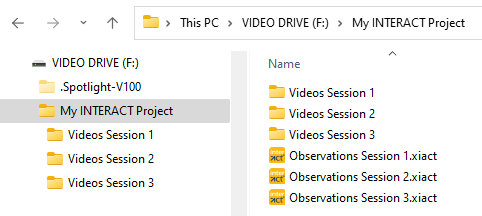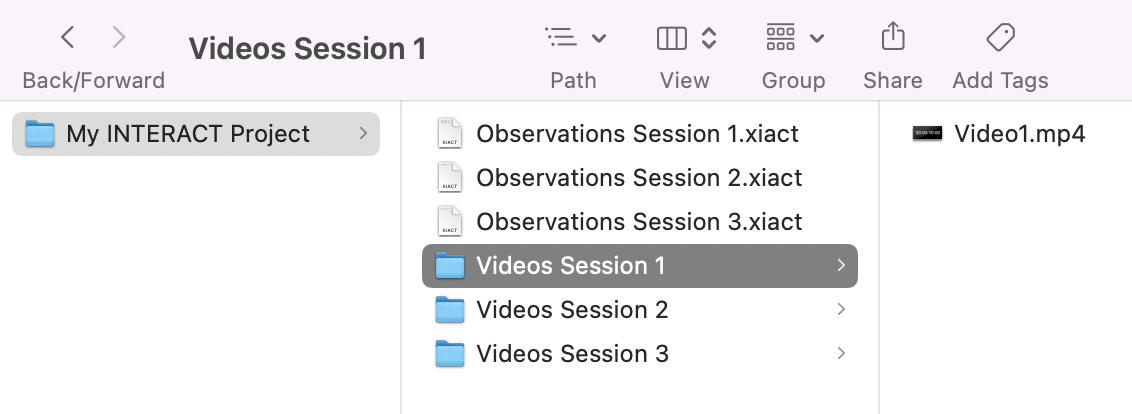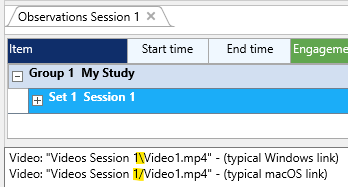INTERACT must be switch into Observation Mode before it can log your Events.
To start the actual logging process, you need to activate INTERACT's Observation Mode:
▪Make sure the required Coding Mode is selected, and your source of observation is available.
▪To activate the Observation Mode, click ![]() .
.
A new file is automatically created, if no data file was open yet.
A dialog appears if you have already opened one or more multimedia files (the moment a new data file is created). It tells you that you should save your document so that INTERACT can insert the best reference to your Multimedia file(s):
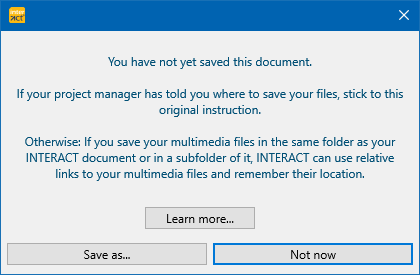
| Cancel: Your multimedia files are automatically linked to the current data set using an absolute reference. |
| Save as...: Recommended! A regular Save as.. dialog appears, asking you where you plan to save your data. |
Depending on where you save your document, INTERACT enters the appropriate link.
Project folder
We recommend to store all INTERACT documents together in the top-level of a "Study" or "Project" folder.
How to structure your videos within that folder depends on the number of recordings per session: For one video per session, a single Videos folder containing all videos will do.
For multiple videos per session we recommend a separate video folder per session, like this:
Windows |
macOS |
This allows you to insert drive letter independent references to your videos, but are still able to keep the videos separated per session:
These type of links work for both Windows and macOS because, depending on the current operating system, INTERACT automatically 'translates' the / or \ slashes internally to make the links work. Thus, you may exchange the same drive among operating systems.
Note: This test situation, showing the two different type of links, should open the same video twice.
If you do not have writing access to video storage drive, an absolute reference to that drive is required.
Depending on where you save your current document, INTERACT enters the link in a different way:
1.If you saved the file into the same folder as your multimedia file(s), only the name of the multimedia file(s) is entered, like this:
Video: "Video1.mp4"
2.If you saved your data file in a location 'above' the currently opened multimedia file(s), like in the top-level of a project folder, as explained above, a relative path is entered.
Such a path includes the folder(s) containing the opened multimedia file(s), starting from the data file location, like this:
Video: "Videos Session 1\Video1.mp4"
3.If you saved your data on another drive or in a completely different folder branch, the full, absolute file reference (including the whole path and drive letter) is entered, like this:
Video: "F:\My INTERACT Project\Videos Session 1\Video1.mp4"
When using a relative reference, the file reference stays valid, for as long as the *.xiact file and linked multimedia file(s) are stored within the same folder or folder path.
Note: The moment you manipulate something in the time information, this information is also stored at the end of the multimedia file reference, like this:
Video: "MangoldSolutions.avi", OffsetMs:2500
Additionally, the button you clicked to start your session, changes to ![]() and the the Active Codes field appears in the toolbar.
and the the Active Codes field appears in the toolbar.
Last but not least, the Coding panel appears, enabling you to log Events with your mouse:
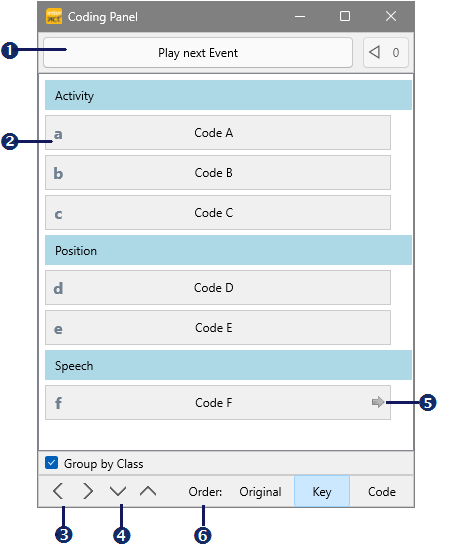
INTERACT is now in Observation mode and ready to log whatever Codes you have defined.
▪According the selected Coding Mode, you can now use your Codes to manually Log Events.
Session Structure
Per default, INTERACT creates a DataGroup and DataSet, whenever your start an observational session, within a new empty document. Typically, each DataSet holds all observations per test situation.
For multiple sessions within one data file, you need to add a DataSet for each session manually.
IMPORTANT: Log Events -that belong to the same observed situation- into the same data file, and in most cases, even inside the same DataSet. Even if you use different Code definitions and multiple passes to collect the data!
| TIP: | During the observation stage, create a new data file for each video, just to prevent accidentally damaging previous observations. Before you start with the Analysis, use the applicable Merge data files routine. |
Add DataSet for new Session
To manually add a DataSet:
▪Click Start - Edit - Add DataSet ![]() in the INTERACT toolbar or use the corresponding little icon in front of the Class column headers.
in the INTERACT toolbar or use the corresponding little icon in front of the Class column headers.
INTERACT creates a new line within the selected DataGroup.
If no DataGroup is available yet, INTERACT automatically creates a DataGroup as well.

▪Enter a descriptive title into the empty 'Set' line; this description also appears in DataSet based statistics!
| TIP: | Further details about structuring your data file, can be found in the section Structure Logged Events. |
